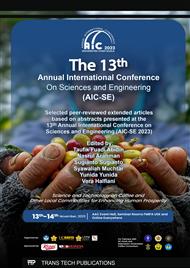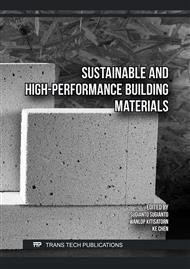[1]
F. Canpolat, K. Yilmaz, M. M. Köse, M. Sümer, and M. A. Yurdusev, "Use of zeolite, coal bottom ash and fly ash as replacement materials in cement production," Cem. Concr. Res., vol. 34, no. 5, p.731–735, 2004.
DOI: 10.1016/S0008-8846(03)00063-2
Google Scholar
[2]
X. Li, F. Rao, S. Song, M. A. Corona-arroyo, N. Ortiz-, and E. A. Aguilar-reyes, "School of Resources and Environmental Engineering , Wuhan University of Technology ," Results Phys., 2018.
DOI: 10.1016/j.rinp.2018.09.018
Google Scholar
[3]
M. Etxeberria, J. M. Fernandez, and J. Limeira, "Secondary aggregates and seawater employment for sustainable concrete dyke blocks production : Case study," Constr. Build. Mater., vol. 113, p.586–595, 2016.
DOI: 10.1016/j.conbuildmat.2016.03.097
Google Scholar
[4]
D. Nagrockiene and G. Girskas, "Research into the properties of concrete modified with natural zeolite addition," Constr. Build. Mater., vol. 113, p.964–969, 2016.
DOI: 10.1016/j.conbuildmat.2016.03.133
Google Scholar
[5]
M. Moshoeshoe, M. Silas Nadiye-Tabbiruka, and V. Obuseng, "A Review of the Chemistry, Structure, Properties and Applications of Zeolites," Am. J. Mater. Sci., vol. 2017, no. 5, p.196–221, 2017.
Google Scholar
[6]
Y. T. Tran, J. Lee, P. Kumar, K. H. Kim, and S. S. Lee, "Natural zeolite and its application in concrete composite production," vol. 165, p.354–364, 2019, doi: 10.1016/j.compositesb. 2018.12.084.
DOI: 10.1016/j.compositesb.2018.12.084
Google Scholar
[7]
ASTM C1585-13, "Standard Test Method for Measurement of Rate of Absorption of Water by Hydraulic Cement Concretes," ASTM Int., vol. 41, no. 147, p.1–6, 2013.
Google Scholar
[8]
Astm C20, "Standard Test Methods for Apparent Porosity, Water Absorption, Apparent Specific Gravity, and Bulk Density of Burned Refractory Brick and Shapes by Boiling Water 1 This international standard was developed in accordance with internationally recognized pri," in ASTM International, 2017, p.20–22.
DOI: 10.1520/c0020-97
Google Scholar
[9]
ASTM C39-01, "Standard Test Method for Compressive Strength of Cylindrical Concrete Specimens 1," in ASTM Standard Book, 2003, p.1–5.
Google Scholar
[10]
ASTM C496/C496M − 17, "Standard Test Method for Splitting Tensile Strength of Cylindrical Concrete Specimens ASTM C-496," in ASTM International, 2011, p.1–5.
Google Scholar
[11]
Z. Dong, G. Wu, X. L. Zhao, H. Zhu, and J. L. Lian, "Durability test on the flexural performance of seawater sea-sand concrete beams completely reinforced with FRP bars," Constr. Build. Mater., vol. 192, p.671–682, 2018.
DOI: 10.1016/j.conbuildmat.2018.10.166
Google Scholar
[12]
ASTM C109/C109M-02, "Standard Test Method for Compressive Strength of Hydraulic Cement Mortars," Annu. B. ASTM Stand., vol. 04, p.9, 2020.
Google Scholar
[13]
Ž. Rudžionis et al., "Natural zeolite powder in cementitious composites and its application as heavy metal absorbents," J. Build. Eng., vol. 43, p.103085, 2021, doi: 10.1016/j.jobe. 2021.103085.
DOI: 10.1016/j.jobe.2021.103085
Google Scholar
[14]
B. Ahmadi and M. Shekarchi, "Use of natural zeolite as a supplementary cementitious material," Cem. Concr. Compos., vol. 32, no. 2, p.134–141, 2010.
DOI: 10.1016/j.cemconcomp.2009.10.006
Google Scholar
[15]
M. F. Nuruddin, K. Y. Chang, and N. M. Azmee, "Workability and compressive strength of ductile self compacting concrete (DSCC) with various cement replacement materials," Constr. Build. Mater., vol. 55, p.153–157, 2014.
DOI: 10.1016/j.conbuildmat.2013.12.094
Google Scholar
[16]
T. Jose, M. P. Benny, and U. G. Scholar, "Feasibility of Sea-Sand Sea-Water Concrete," vol. 8, no. 08, p.18–25, 2019.
Google Scholar
[17]
J. Gražulytė, A. Vaitkus, O. Šernas, and D. Čygas, "Effect of silica fume on high-strength concrete performance," World Congr. Civil, Struct. Environ. Eng., no. October, pp.162-162–6, 2020.
DOI: 10.11159/icsect20.162
Google Scholar
[18]
H. Mola-Abasi, A. Khajeh, and S. Naderi Semsani, "Effect of the Ratio between Porosity and SiO2 and Al2O3 on Tensile Strength of Zeolite-Cemented Sands," J. Mater. Civ. Eng., vol. 30, no. 4, p.1–9, 2018.
DOI: 10.1061/(asce)mt.1943-5533.0002197
Google Scholar
[19]
H. Mola-Abasi and I. Shooshpasha, "Influence of zeolite and cement additions on mechanical behavior of sandy soil," J. Rock Mech. Geotech. Eng., vol. 8, no. 5, p.746–752, 2016.
DOI: 10.1016/j.jrmge.2016.01.008
Google Scholar



